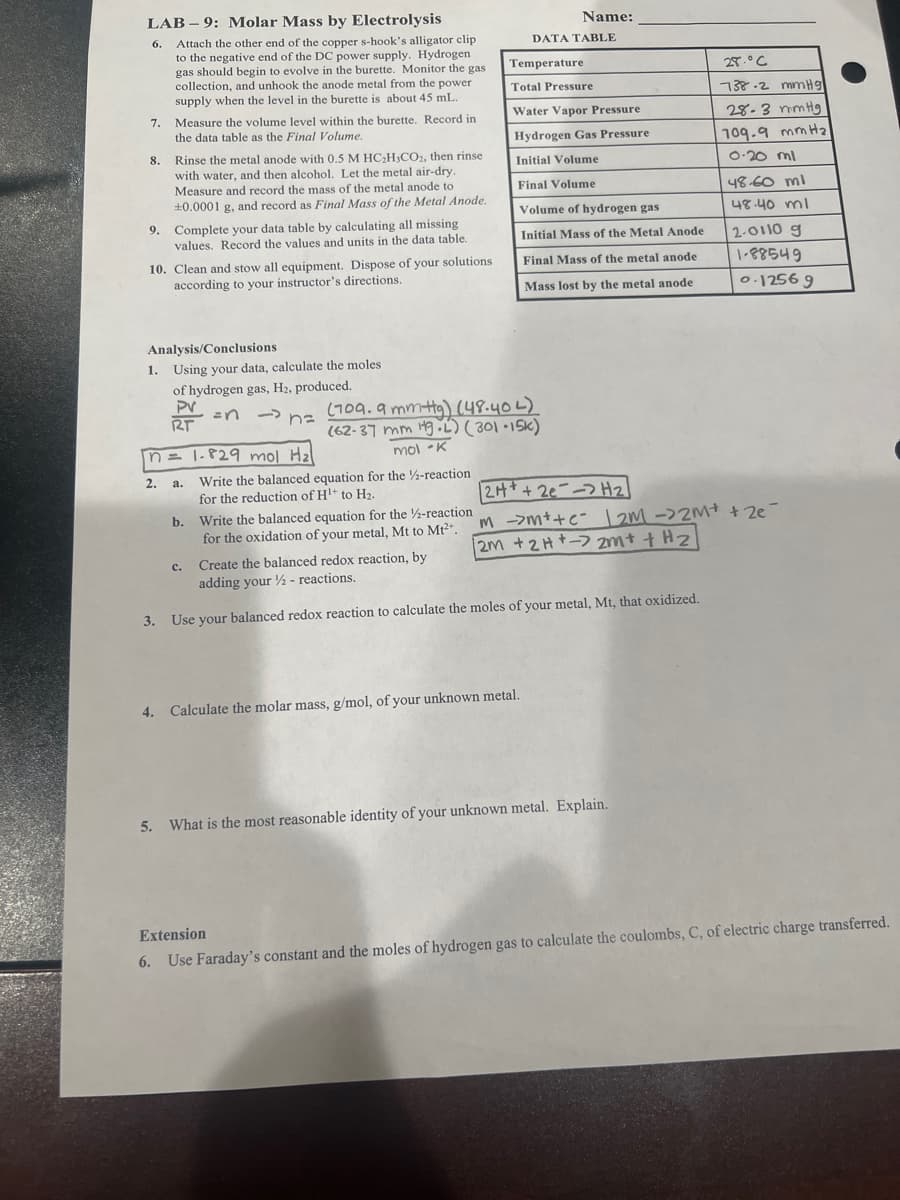Chapter4: Least-squares And Calibration Methods
Section: Chapter Questions
Problem 5P
Related questions
Question
2c, 3, 4, 5

Transcribed Image Text:LAB-9: Molar Mass by Electrolysis
Attach the other end of the copper s-hook's alligator clip
to the negative end of the DC power supply. Hydrogen
gas should begin to evolve in the burette. Monitor the gas
collection, and unhook the anode metal from the power
supply when the level in the burette is about 45 mL.
6.
7.
Measure the volume level within the burette. Record in
the data table as the Final Volume.
8.
Rinse the metal anode with 0.5 M HC₂H3CO2, then rinse
with water, and then alcohol. Let the metal air-dry.
Measure and record the mass of the metal anode to
+0.0001 g, and record as Final Mass of the Metal Anode.
9. Complete your data table by calculating all missing
values. Record the values and units in the data table.
10. Clean and stow all equipment. Dispose of your solutions
according to your instructor's directions.
Analysis/Conclusions
1. Using your data, calculate the moles
of hydrogen gas, H₂, produced.
PV
RT
=n →n=
n = 1.829 mol H₂
2.
a.
Write the balanced equation for the 2-reaction
for the reduction of H¹+ to H₂.
b. Write the balanced equation for the 2-reaction
for the oxidation of your metal, Mt to Mt²+.
C.
Name:
DATA TABLE
Temperature
(709.9 mmHg) (48.402)
(62-37 mm Hg.L) (301-15k)
mol-K
Total Pressure
Water Vapor Pressure
Hydrogen Gas Pressure
Initial Volume
Final Volume
Volume of hydrogen gas
Initial Mass of the Metal Anode
Final Mass of the metal anode
Mass lost by the metal anode
Create the balanced redox reaction, by
adding your ½ - reactions.
3. Use your balanced redox reaction to calculate the moles of your metal, Mt, that oxidized.
4. Calculate the molar mass, g/mol, of your unknown metal.
28.°C
738-2 mmHg
28-3 mmHg
109.9 mm H₂
0.20 ml
2H+ + 2e--> H₂
M ->m++c-12M ->2M+ +2e=
2m + 2H+-> 2m+ + H₂
5. What is the most reasonable identity of your unknown metal. Explain.
48.60 ml
48.40 ml
2-0110 g
1-88549
0.12569
Extension
6. Use Faraday's constant and the moles of hydrogen gas to calculate the coulombs, C, of electric charge transferred.
Expert Solution
This question has been solved!
Explore an expertly crafted, step-by-step solution for a thorough understanding of key concepts.
Step by step
Solved in 4 steps

Knowledge Booster
Learn more about
Need a deep-dive on the concept behind this application? Look no further. Learn more about this topic, chemistry and related others by exploring similar questions and additional content below.Recommended textbooks for you


Principles of Instrumental Analysis
Chemistry
ISBN:
9781305577213
Author:
Douglas A. Skoog, F. James Holler, Stanley R. Crouch
Publisher:
Cengage Learning



Principles of Instrumental Analysis
Chemistry
ISBN:
9781305577213
Author:
Douglas A. Skoog, F. James Holler, Stanley R. Crouch
Publisher:
Cengage Learning
